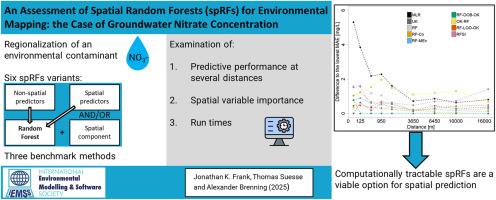空间随机森林环境制图评价:以地下水硝酸盐浓度为例
IF 4.6
2区 环境科学与生态学
Q1 COMPUTER SCIENCE, INTERDISCIPLINARY APPLICATIONS
引用次数: 0
摘要
随机森林(RF)及其空间变异等机器学习模型在环境污染物区域化中越来越受欢迎。到目前为止,在这一领域还没有空间射频变异的经验比较。本研究的目的是评估六种空间射频变异,并将其与通用克里格(UK)和多元线性回归(MLR)进行比较。我们以地下水硝酸盐浓度区划为例,对不同预测距离的预测性能进行了实证检验。空间RF变异之间的差异通常很小。在预测距离小于实际自相关范围的情况下,空间变量的预测精度往往高于非空间RF和MLR。RF-OOB-OK使用基于袋外误差的普通克里格预测,是表现更稳定的方法之一。在对环境污染物进行空间预测时,计算上可处理的空间射频变量可被认为是地质统计区划方法的可行替代方法。本文章由计算机程序翻译,如有差异,请以英文原文为准。

An assessment of spatial random forests for environmental mapping: the case of groundwater nitrate concentration
Machine-learning models such as random forests (RF) and their spatial variants are increasingly popular in the regionalization of environmental contaminants. To date, no empirical comparison of spatial RF variants is available in this field.
The purpose of this study is to evaluate six spatial RF variants, benchmarking them against universal kriging (UK) and multiple linear regression (MLR). We empirically examine predictive performances over different prediction distances using the regionalization of nitrate concentrations in groundwater as a case study.
Differences among spatial RF variants were generally small. Over prediction distances shorter than the practical range of autocorrelation, spatial variants tended to achieve higher precisions than non-spatial RF and MLR. RF-OOB-OK that uses ordinary kriging predictions based on the out-of-bag error appeared as one of the more consistently well-performing methods.
Computationally tractable spatial RF variants can be considered viable alternatives to geostatistical regionalization methods in making spatial predictions of environmental contaminants.
求助全文
通过发布文献求助,成功后即可免费获取论文全文。
去求助
来源期刊

Environmental Modelling & Software
工程技术-工程:环境
CiteScore
9.30
自引率
8.20%
发文量
241
审稿时长
60 days
期刊介绍:
Environmental Modelling & Software publishes contributions, in the form of research articles, reviews and short communications, on recent advances in environmental modelling and/or software. The aim is to improve our capacity to represent, understand, predict or manage the behaviour of environmental systems at all practical scales, and to communicate those improvements to a wide scientific and professional audience.
 求助内容:
求助内容: 应助结果提醒方式:
应助结果提醒方式:


